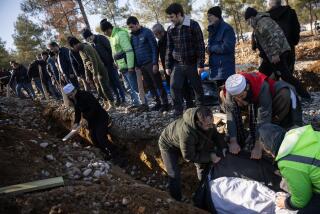War Fatigue: Out of Sight, Out of Mind
- Share via
COLOMBO, Sri Lanka — The civil war in Sri Lanka rages on. In the government’s latest offensive, the casualties on both sides continue to mount. By some estimates, more than 50,000 people have died in the ethnic conflict between the Liberation Tigers of Tamil Eelam and the government since 1983. The Colombo press gives its customary casualty reports and troop movements and then, almost casually, goes on to talk of cricket scores. The pictures of bloody corpses and the stories about thousands of displaced persons no longer seem to lift eyebrows, and most of us here, far removed from the fighting, appear more bothered than concerned by the endless bloodshed.
Outside of the obligatory press reports on the war, our only other true brush with the conflict is the sound of ambulances along Colombo’s main street. Wounded and dying soldiers are evacuated from the front to the Ratmalana airport and then down Galle Road to Colombo’s General Hospital. Most of us seem more disturbed by the decibel levels of the ambulance sirens than by the fate of those inside.
The government of Sri Lanka has approached the conflict with a stick in one hand and a fig leaf in the other. Beat down the terrorists militarily while offering them options for peace. That seems to be the conventional wisdom, at least for this year. The most promising nonmilitary option so far is an extensive proposal to devolve authority to the country’s predominantly Tamil regions. But even the “package,” as it is now called, has gotten hung up in debate, and most of us suspect that if it ever gets through the quagmire of parliamentary approvals, it will be so watered down as to mean little if anything at all. Discussion of the package is now met with yawns more often than with debate.
It certainly is true that Colombo is home to more than a few nongovernmental organizations that advocate peace. Most of these organizations are filled with the sons and daughters of the elite, people who will never see the battle up close, people who do not have friends that have sacrificed everything in the war, people who are more comfortable sermonizing about the “root causes” of the conflict than they are about contributing to its solution.
And then there are the international donor organizations that support these so-called peaceniks. For many of them, supporting the elitist peace movement is the only way they know to do something about this seemingly intractable conflict. In fact, many of them do nothing more than support a cottage industry of talk shops, peace marches and more research on root causes. Meanwhile, the rest of us continue to browse through the newspapers, taking little notice of the war and its mostly silent victims.
What is going on here? How can this national tragedy be met with such complacency? The simple answer is that we have become tired of the blood and the seeming hopelessness of it all. People who are not directly affected by this disaster, no matter how great its magnitude or how long it may last, have lost interest. Colombo, so far away from the battlefields in the north and the east of the country, lapses into deep slumber while the body counts continue to rise.
Sadly, it may take a tragedy closer to home before the capital city and the international news organizations once again take notice of one of the world’s most bloody and lingering conflicts. On Jan. 31, 1996, when a powerful Liberation Tigers’ bomb exploded in front of the downtown Central Bank building killing and maiming scores of people, Colombo took note, as did the rest of the world. And for a brief time there was a serious effort to come to grips with the situation. But now even that memory has faded, replaced only by the ambulances going from the airport to the hospital.
More to Read
Sign up for Essential California
The most important California stories and recommendations in your inbox every morning.
You may occasionally receive promotional content from the Los Angeles Times.









